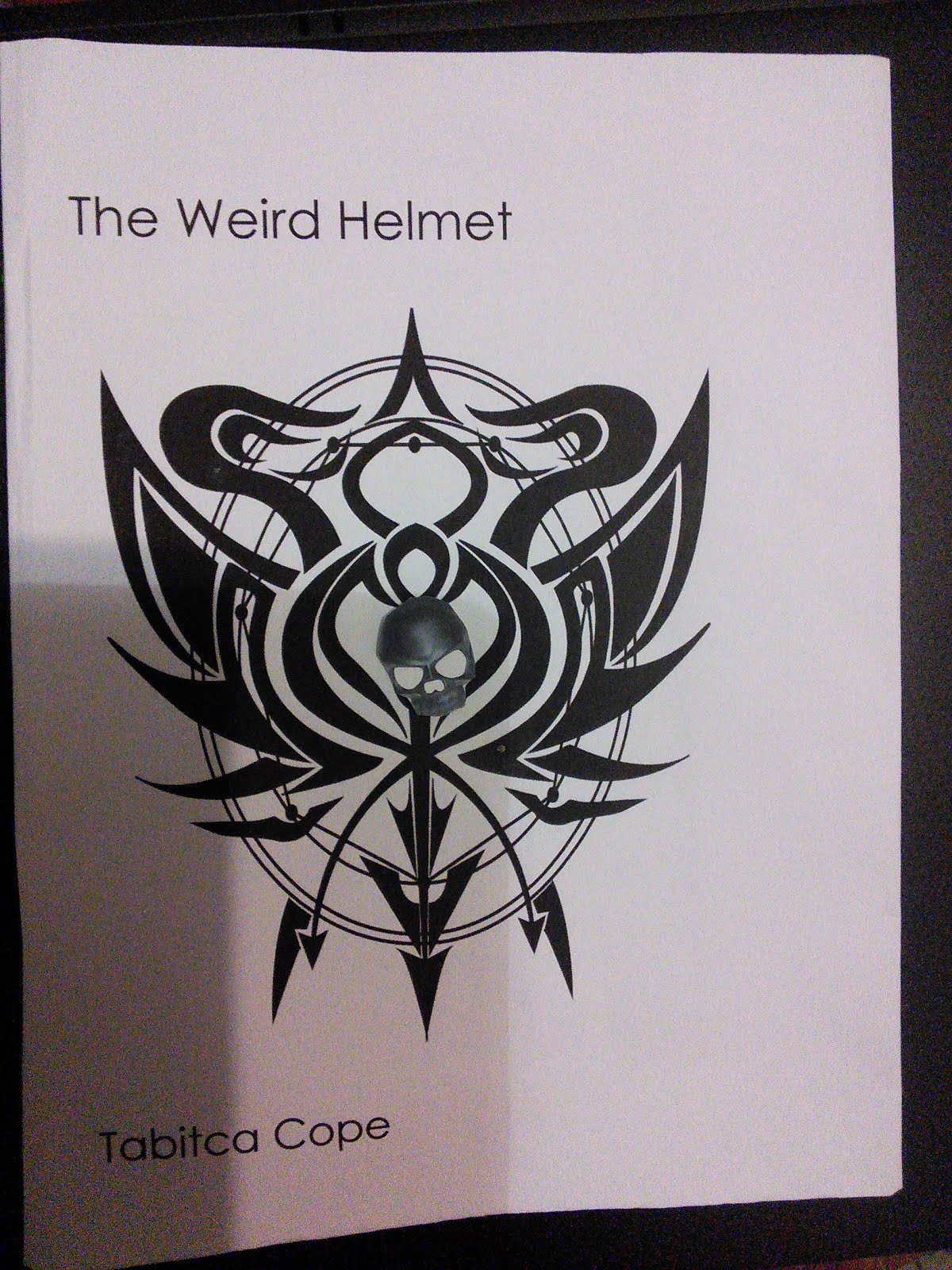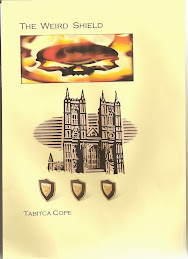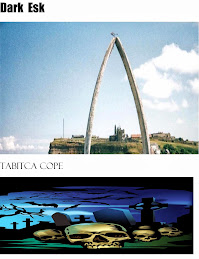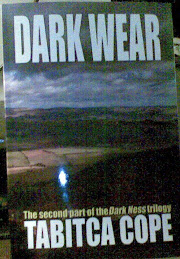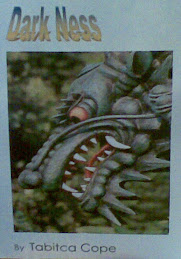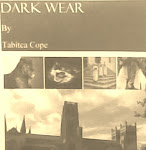Vampire bats are not exactly cryptozoological but are creatures of legend and myths from all over the world ,especially Europe. Vampire bats do exist, but only in Central and South America, not in Transylvania . The three species are :the common vampire bat (Desmodus rotundus), the white-winged vampire bat (Diaemus, or Desmodus, youngi) and the hairy-legged vampire bat (Diphylla ecaudata) . So where does the name come from?"Bat" comes from Old Norse "ledhrblaka," or "leather flapper." It became "bakka" and then "bat." "Vampire" comes from Magyar "vampir," meaning "witch" not blood sucker as such. Bats are in the single order, Chiroptera (hand-winged) and are thought to have appeared n the late Palaeocene or early Cretaceous (Altringham 1996). There is poor representation of bats in the fossil record.
The bats have a wingspan of approximately eight inches and a body about three inches long .They tend to feed on the blood of large birds, cattle, horses, and pigs. However, they don’t suck the blood of their prey but use their teeth, to make small cuts in the skin of a sleeping animal. The bats' saliva contains a chemical that keeps the blood from clotting. The bats then lap up the blood that oozes from the wound. Another chemical in their saliva numbs the animal's skin and keeps them from waking up. A vampire bat finds its prey with echolocation( like radar ), smell, and sound. They fly about one meter above the ground. Then they use special heat sensors in their noses to find veins that are close to the skin.
They live in colonies which have quite strong social bonds, grooming each other and recognizing their fellows with voice and smell. The structure is imperative to their survival, as there are many nights when a bat may not find a host to feed on. The hungry bats are fed from others through a process of regurgitation. If vampire bats do not get their share of blood on a regular basis, they rapidly deteriorate. A bat may be close to starvation within 2-3 days (Altringham 1996). . In the wild, vampire bats live to about 9 years old, but can reach 20 years in captivity. Vampire bats mate all year round. The bat may consume up to 60% of its body weight in blood and it only needs the red blood cells, it will begin excreting plasma before its meal is over. With a specialized stomach and kidneys, the vampire rapidly removes the plasma as it may take up to twenty minutes to the bat to finish its meal (Altringham 1996).
Central and South America are alive with superstitions about the vampire bat. It is said that bats are dirty germ carriers feeding on human blood or that they have supernatural powers allowing them to change shapes from man to bat. While these legends may sound strange, there is recorded evidence of human hosts. Glover Allen (1939)wrote about bats feeding on humans, “while travelling down the Amazon valley, he (Dr. William Farabee) awoke one morning to find that a vampire during the night had gouged a small piece of skin from the tip of his nose and had evidently feasted while he slept, for the wound was still bleeding slightly” . Not all tales are negative; bloodletting has traditionally held healing qualities.
Western literature has embraced the vampire bat making it popular in fiction with Dracula stories as they did not appear in early vampire myth. The European folklore of vampires did not incorporate the bat probably because they did not exist in Europe. Apart from the captive animals in zoos, vampire bats have apparently never been found outside of the Americas. See articles below about the vampire bat as disease carrier.
Vampire bats blamed for Venezuela rabies outbreak
By Ian James in Caracas, Venezuela Sunday, 10 August 2008
see : http://www.independent.co.uk/news/world/americas/vampire-bats-blamed-for-venezuela-rabies-outbreak-889772.html
At least 38 Venezuelans have died as a result of a suspected outbreak of rabies spread by bites from vampire bats. Laboratory tests have yet to confirm the cause, but the symptoms point to rabies, say researchers from the University of California at Berkeley and other medical experts. At least 38 Warao Indians have died since June 2007, 16 of them since the start of June this year, according to a report that the Berkeley researchers, an anthropologist and public health specialist, and indigenous leaders provided to Venezuelan officials last week. All the victims died within two to seven days after the onset of symptoms. One village, Mukuboina, lost eight of its roughly 80 inhabitants – all of them children. Health officials investigating the outbreak are now planning to distribute mosquito nets to prevent bat bites and send a medical boat to provide treatment in the remote villages on the Orinoco river delta.Outbreaks of rabies spread by vampire bats are a problem in various tropical areas of South America, including Brazil and Peru. The common vampire bat, which feeds on mammals' blood, swoops down and generally approaches its sleeping prey on the ground. The bat then makes a small incision with its teeth, and an anticoagulant in its saliva keeps the blood flowing while it drinks the blood. Symptoms of rabies include fever, tingling in the feet followed by paralysis, and an extreme fear of water.
And also this article from 2005: http://www.livescience.com/animals/051104_vampire_bats.html
Excerpt from article :Bites from rabid vampire bats were blamed for 23 deaths in northern Brazil over the past two months, according to local newspaper reports. Many scientists fear such encounters will become more common as the bats' forests homes are destroyed and they are lured towards cattle ranches and farms where livestock and humans make easy prey. A common one is that the bats bite the throats of their human victims. The truth is a little less glamorous."They're more likely to go for a person's big toe," French told LiveScience. "There's a good blood supply there and the bite is usually less noticeable."Also, instead of sucking the blood of their victims as is generally believed, vampire bats make a small tear in their victim's skin and lap at the blood as it oozes out. When the bats have finished their meal, they're often so engorged with blood that they're too heavy to fly. The bats have to crawl off their sleeping victims and go someplace to digest their meal before returning home. A lot of human deaths could be prevented if people take simple precautions, French said.
Ker Than, LiveScience Staff Writer posted: 04 November 2005
It seems such a shame that these animals could be made extinct by humans destroying their homes and forcing them into a position where their hunting makes them open to being eradicated. They will then be true cryptozoological legends , and I for one hope that doesn’t happen.
Altringham, John D. 1996. Bats, Biology and Behavior Oxford University Press;Vampire Bats , legend and reality.
Vampire bats are not exactly cryptozoological but are creatures of legend and myths from all over the world ,especially Europe. Vampire bats do exist, but only in Central and South America, not in Transylvania . The three species are :the common vampire bat (Desmodus rotundus), the white-winged vampire bat (Diaemus, or Desmodus, youngi) and the hairy-legged vampire bat (Diphylla ecaudata) . So where does the name come from?"Bat" comes from Old Norse "ledhrblaka," or "leather flapper." It became "bakka" and then "bat." "Vampire" comes from Magyar "vampir," meaning "witch" not blood sucker as such. Bats are in the single order, Chiroptera (hand-winged) and are thought to have appeared n the late Palaeocene or early Cretaceous (Altringham 1996). There is poor representation of bats in the fossil record.
The bats have a wingspan of approximately eight inches and a body about three inches long .They tend to feed on the blood of large birds, cattle, horses, and pigs. However, they don’t suck the blood of their prey but use their teeth, to make small cuts in the skin of a sleeping animal. The bats' saliva contains a chemical that keeps the blood from clotting. The bats then lap up the blood that oozes from the wound. Another chemical in their saliva numbs the animal's skin and keeps them from waking up. A vampire bat finds its prey with echolocation( like radar ), smell, and sound. They fly about one meter above the ground. Then they use special heat sensors in their noses to find veins that are close to the skin.
They live in colonies which have quite strong social bonds, grooming each other and recognizing their fellows with voice and smell. The structure is imperative to their survival, as there are many nights when a bat may not find a host to feed on. The hungry bats are fed from others through a process of regurgitation. If vampire bats do not get their share of blood on a regular basis, they rapidly deteriorate. A bat may be close to starvation within 2-3 days (Altringham 1996). . In the wild, vampire bats live to about 9 years old, but can reach 20 years in captivity. Vampire bats mate all year round. The bat may consume up to 60% of its body weight in blood and it only needs the red blood cells, it will begin excreting plasma before its meal is over. With a specialized stomach and kidneys, the vampire rapidly removes the plasma as it may take up to twenty minutes to the bat to finish its meal (Altringham 1996).
Central and South America are alive with superstitions about the vampire bat. It is said that bats are dirty germ carriers feeding on human blood or that they have supernatural powers allowing them to change shapes from man to bat. While these legends may sound strange, there is recorded evidence of human hosts. Glover Allen (1939)wrote about bats feeding on humans, “while travelling down the Amazon valley, he (Dr. William Farabee) awoke one morning to find that a vampire during the night had gouged a small piece of skin from the tip of his nose and had evidently feasted while he slept, for the wound was still bleeding slightly” . Not all tales are negative; bloodletting has traditionally held healing qualities.
Western literature has embraced the vampire bat making it popular in fiction with Dracula stories as they did not appear in early vampire myth. The European folklore of vampires did not incorporate the bat probably because they did not exist in Europe. Apart from the captive animals in zoos, vampire bats have apparently never been found outside of the Americas. See articles below about the vampire bat as disease carrier.
Vampire bats blamed for Venezuela rabies outbreak
By Ian James in Caracas, Venezuela Sunday, 10 August 2008
see : http://www.independent.co.uk/news/world/americas/vampire-bats-blamed-for-venezuela-rabies-outbreak-889772.html
At least 38 Venezuelans have died as a result of a suspected outbreak of rabies spread by bites from vampire bats. Laboratory tests have yet to confirm the cause, but the symptoms point to rabies, say researchers from the University of California at Berkeley and other medical experts. At least 38 Warao Indians have died since June 2007, 16 of them since the start of June this year, according to a report that the Berkeley researchers, an anthropologist and public health specialist, and indigenous leaders provided to Venezuelan officials last week. All the victims died within two to seven days after the onset of symptoms. One village, Mukuboina, lost eight of its roughly 80 inhabitants – all of them children. Health officials investigating the outbreak are now planning to distribute mosquito nets to prevent bat bites and send a medical boat to provide treatment in the remote villages on the Orinoco river delta.Outbreaks of rabies spread by vampire bats are a problem in various tropical areas of South America, including Brazil and Peru. The common vampire bat, which feeds on mammals' blood, swoops down and generally approaches its sleeping prey on the ground. The bat then makes a small incision with its teeth, and an anticoagulant in its saliva keeps the blood flowing while it drinks the blood. Symptoms of rabies include fever, tingling in the feet followed by paralysis, and an extreme fear of water.
And also this article from 2005: http://www.livescience.com/animals/051104_vampire_bats.html
Excerpt from article :Bites from rabid vampire bats were blamed for 23 deaths in northern Brazil over the past two months, according to local newspaper reports. Many scientists fear such encounters will become more common as the bats' forests homes are destroyed and they are lured towards cattle ranches and farms where livestock and humans make easy prey. A common one is that the bats bite the throats of their human victims. The truth is a little less glamorous."They're more likely to go for a person's big toe," French told LiveScience. "There's a good blood supply there and the bite is usually less noticeable."Also, instead of sucking the blood of their victims as is generally believed, vampire bats make a small tear in their victim's skin and lap at the blood as it oozes out. When the bats have finished their meal, they're often so engorged with blood that they're too heavy to fly. The bats have to crawl off their sleeping victims and go someplace to digest their meal before returning home. A lot of human deaths could be prevented if people take simple precautions, French said.
Ker Than, LiveScience Staff Writer posted: 04 November 2005
It seems such a shame that these animals could be made extinct by humans destroying their homes and forcing them into a position where their hunting makes them open to being eradicated. They will then be true cryptozoological legends , and I for one hope that doesn’t happen.
Altringham, John D. 1996. Bats, Biology and Behavior Oxford University Press;
University of Leeds, New York.
Allen, Glover Morrill. 1939. Bats Dover Publications; Harvard University, New York.
University of Leeds, New York.
Allen, Glover Morrill. 1939. Bats Dover Publications; Harvard University, New York.

